MACV-SOG: Covert Operations in Vietnam

The Military Assistance Command Vietnam, Special Operations Group (MACV-SOG) was an elite American special force tasked with conducting covert operations in Vietnam.
In 1964, due to the increasing number of American military activities in Vietnam, the American military structure underwent a marked change. Thus, the Military Assistance Command, Vietnam, Studies and Operations Group (MACV-SOG) was established in January 1964. Sometimes referred to simply as the "SOG", the discreetly named unit was responsible for all sorts reconnaissance, special operations and psyops in Vietnam during the Vietnam War.

The group consisted of Navy SEALs, Marine Recons, Air Force Special Ops soldiers, and Army Green Berets [ source ]. The force was above top secret - agents were sworn to secrecy for over 20 years. This unfortunately meant that the families of MACV-SOG members were not informed if their loved ones had been killed in action [ source ].
1. Operational structure
1.1. command control
MACV-SOG fell under the control of US Military Assistance Command Vietnam, the US military command providing military assistance to South Vietnam. The Military Assistance Command was a subsidiary of the US Indo-Pacific Command. The first commander of MACV-SOG was Colonel Clyde Russell.
MACV-SOG had its headquarters in Saigon (now Ho Chi Minh City), with its subordinate units having several operational bases across Vietnam and surrounding territories [ source ].
However, MACV-SOG had direct instructions from the Pentagon on specific missions. Specifically, from the Special Assistant for Counterinsurgency and Special Activities (SACSA) and his staff at the Pentagon [ source ].
1.2. Subsidiary units
In the early years of MACV-SOG, the unit operated in smaller units under a single command. This created a complex command structure that was difficult to maintain due to the widely varying requirements of each region.
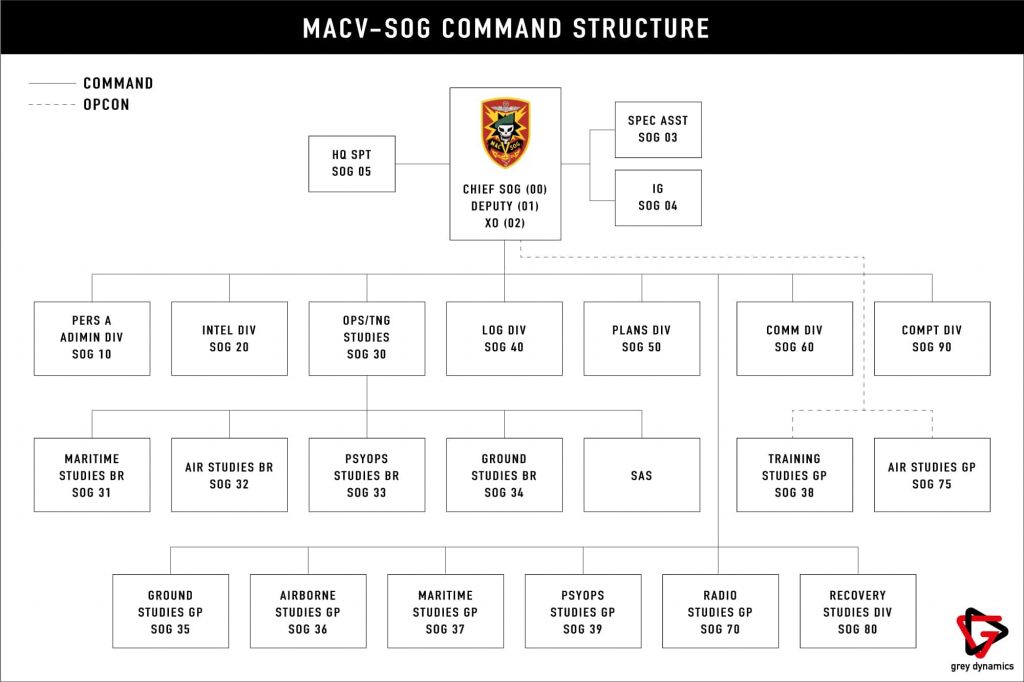
As the unit matured and the Vietnam War progressed, MACV-SOG split into regional commands:
- Command and Control North (based in Da Nang) - operated in southern Laos and northern Cambodia
- Command and Control Central (based in Kontum) - conducted similar operations to Command and Control North, operating in southern Laos and northern Cambodia
- Command and Control South (based in Ban Me Thout) - operated exclusively in southern Cambodia.
2. Equipment
The equipment carried by MACV-SOG was very different from that of traditional armed forces, due to the unconventional warfare they engaged in. The unit primarily carried variants of the XM-177, an experimental carbine variant of the M16 rifle used by conventional forces [ source ].
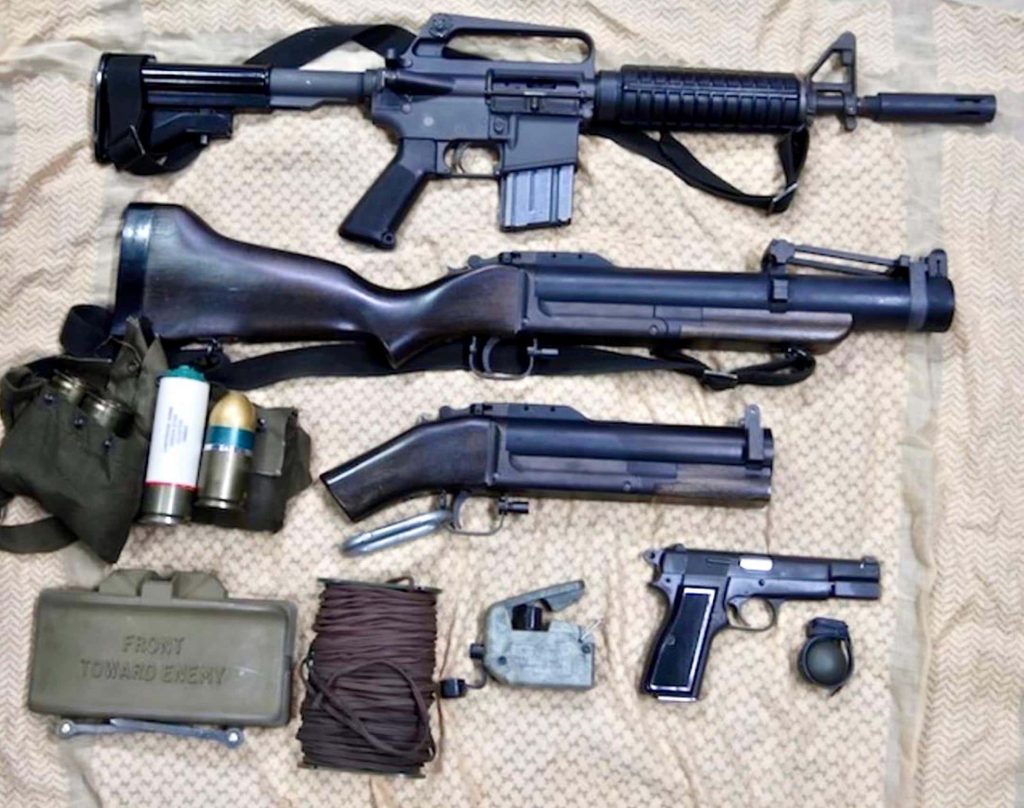
2.1 XM-177
In many ways, the XM-177 was the precursor to the M4. Colt would eventually take many features from the XM-177 and implement them into their iterative rifle designs. There were two official XM-117s, the XM-177 E1 and the XM-177 E2. The nomenclature of "XM" indicates that this is an experimental design that has not yet been formally adopted. The E denotes an “improvement”.
2.1.1. Statistics
- Maker : Colt Defense
- Barrel length: 25.4cm (10") (E1) / 29.2cm (11.5") (E2)
- Overall length : 72 cm (28.3 in) (E1, stock retracted) / 76 cm (29.8 in) (E2, stock retracted)
- Operating system : direct gas impact, powered box loader
- Caliber: 5.56x45mm NATO
- Weight : ~ 2.43 kg (5.35 lbs)
- Maximum effective range: 400m
2.1.2. barrel
The XM-177 E-1 featured a 25.4 cm (10 in) barrel. It is half the length of the M16 from which the XM-177 is derived. However, the XM-177 had an additional muzzle device called moderator . The moderator added an extra 10.6 cm (4.2 in) to the barrel, reducing much of the XM-177's compactness. The exact purpose of the moderator is widely debated. Due to the presence of internal baffles like a suppressor, some have claimed that it reduces decibels enough to make it sound like an AK-47 when fired.
However, the most likely reason for the moderator was to improve reliability. At this time, Colt had difficulty operating their short-barreled rifles reliably. This is mainly due to the lack of dwell time, the distance between the gas port inside the barrel and the muzzle. On a 25.4 cm (10 in) barrel, the gas port and muzzle are very close to each other, reducing the time it takes for the gas behind the bullet to pass through the gas port and cycle action before the ball pops out and the pressure drops.
Baffles on the inside of the moderate slow the gas down, reducing decibel levels when firing. However, they also significantly increase the back pressure even after the bullet exits the muzzle. As a result, there is more gas pressure inside the system, allowing it to operate more reliably.
2.1.3. The stock
The other major change between the XM-177 and the M16 was the stock. Early Colt prototypes tried to convert the fixed stock to a collapsible stock. They were fragile, however, and as a result Colt went back to the drawing board. The XM-177 featured the basic collapsed stock design that was applied to the M4 and all of its derivatives. The stock of the XM-177 had two positions: fully extended and fully collapsed. Later rifle designs would improve on this by increasing the positions from two to four, then to six. Allowing the user to adjust the stock for comfort based on their size and armor.
The sliding stock itself was originally made of aluminum with a protective coating. Subsequent iterations copied the basic design but replaced the aluminum with plastic. This provided both a lighter rifle while reducing production costs.
2.1.4. The second improvement
The next iteration of the XM-177 was the E2. The E2 retained most of the functionality of the E1, with only one major change. Barrel length was increased to 29.2 cm (11.5 in). This had a minor reducing effect on the rifle's flash and sound when firing. This also increased dwell time and therefore reliability. However, the E2 retained the moderator but included a pomegranate ring mounted behind him. The increased length of the E2 combined with the grenade ring allowed the user to mount a grenade launcher under the barrel.
2.1.5. Beyond
As noted earlier, the XM-177 was the precursor to many modern military rifles. Its influence can be seen in Colt's various iterative rifles and eventually the M4. Recognizing that the moderator increased the overall barrel length to 36 cm (14.2 in), Colt standardized on a barrel length of 36.8 cm (14.5 in). The extended barrel offered the user a more effective weapon in the same size package. By replacing the 10.6 cm (4.2 in) moderator with more barrel, they were able to increase reliability and lethality. The longer barrel allows the bullet to reach higher velocities, giving it better terminal ballistics.
The Army would eventually redesign the 25.4 cm (10 in) gun with the Mk 18. However, this time the Navy Crane Division was able to increase the gas port diameter and length to 26.2 cm (10.3 in). As a result, much of the reliability issues were resolved and the Mk 18 would be widely used by US Special Operations Forces.
In addition, depending on mission requirements, MACV-SOG agents also carried:
2.2. AK variants
MACV-SOG members often used enemy weapons for a multitude of reasons. Enemy forces carried a multitude of weapons, including old bolt-action rifles. However, if the SOG riflemen were to use an enemy weapon, it would be an AK variant. During the Vietnam War, this could mean anything from a Soviet-produced AKM to a Chinese Type 56. The Type 56 is an amalgamation of various Soviet weapon designs. The receiver is milled like a stock AK-47 and the stock/pistol grip mounts accordingly. However, the handguard is similar to that of an AKM and it features a vented gas tube. Additionally, it has an integrated folding bayonet like a post-WW2 SKS.

2.2.1. Statistics
- Maker : several manufacturers
- Barrel length: 41.4 cm (16.3 in)
- Total length : 88.2 cm (34.7 in)
- Operating system : long-stroke gas piston, powered box magazine
- Caliber: 7.62x39mm
- Weight : ~ 3.7 kg (8.16 lbs)
- Maximum effective range: 400m
2.3. RPS
The RPD is another Soviet design favored by MACV-SOG operators. The closest parallel the US military had at the time was the M60 machine gun. However, the M60 was bulky, heavy, and fired a heavy 7.62x51mm NATO cartridge. The M60 was not suitable for SOG's needs. However, they still needed a support weapon, so operators began modifying captured enemy RPDs.
The RPD is a belt-fed light machine gun, chambered in 7.62x39mm. It was made in the Soviet Union, China, and a host of other countries. Typically, SOG operators would downsize the barrel, which meant losing the front sight of the weapon. However, the machine gunners would compensate with point fire or hip fire as close to the thick Vietnamese jungles.
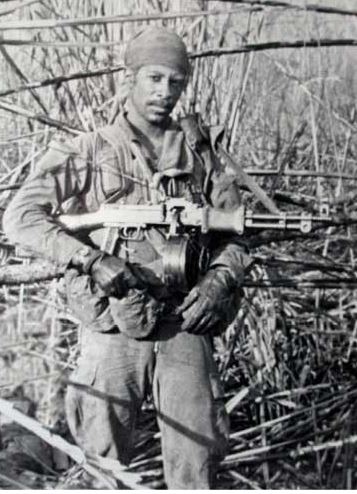
2.3.1. Statistics (non-reduced version)
- Maker : several manufacturers
- Barrel length: 20.5" (52cm)
- Total length : 103.7 cm (40.8 in)
- Operating system : long stroke gas piston, belt fed
- Caliber: 7.62x39mm
- Weight : ~7.4 kg (16.31 lbs)
- Maximum effective range: ~600m
2.4. M79 grenade launcher
The M79 was one of the first autonomous grenade launchers. The M79 fires stand-alone 40mm grenades, unlike the rifle grenades it replaced. Rifle grenades required a special muzzle device, high-pressure blank cartridges, and a shut-off gas system to fire properly. There were huge margins of error if the soldier forgot a step, especially if he forgot to change live ammunition for blanks. These developments allowed the grenadier to deliver much greater firepower at a faster rate. The main drawback was that the grenadier no longer had a battle rifle. Consequently, they relied on their pistol and/or fellow riflemen to engage nearby targets. Often, SOG operators would cut the stock and barrel off the M79 in order to have a lighter, more compact package.
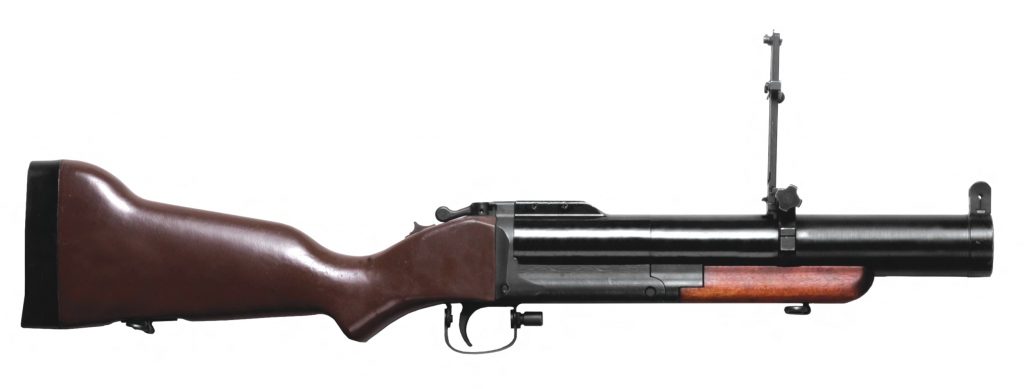
2.4.1. Statistics
- Maker : Springfield Armory and others.
- Barrel length: 14.5" (36.83cm)
- Total length : 73 cm (28.8 in)
- Operating system : Single shot, breaking action
- Caliber: 40mm shell
- Weight : ~ 2.7 kg (6 lbs)
- Maximum effective range: 400m
2.5. Explosives
SOG operators loved frag grenades. They work wonders for clearing enemy combat positions such as bunkers and for breaking contact. A typical SOG loadout consisted of around 10-12 grenades. Additionally, SOG operators sometimes packed Claymore mines as initiators of ambushes. Operators would wait for the enemy to enter their range, then they would detonate the mine to kill as many enemies as possible and stun any that weren't killed. They would then open fire with their weapons to complete the ambush
- V-22 mini grenades
- M-26 Frag Grenades
- M-33 Frag Grenades
- Claymore Mines
2.6. Denial
During the early years of the Vietnam War, the United States denied having troops operating outside of South Vietnam. As a result, SOG operators wore sterilized uniforms and carried weapons without serial numbers to provide a semblance of denial if soldiers, and the United States by extension, were caught operating in areas where they did not. weren't supposed to find each other . ]. This is also a contributing reason for MACV-SOG operators to use captured AKs and RPDs as well. Typically, the point man would carry an AK or RPD due to the distinctive sound of the 7.62x39mm round shot. The report of the weapon is easily distinguished from that of an M16/XM-177. Having the point man wield an enemy's weapon means that if he has to fire a short burst at an isolated enemy, the unit is less likely to be compromised. Other enemies in the area will not be able to easily identify them as US forces by sound.
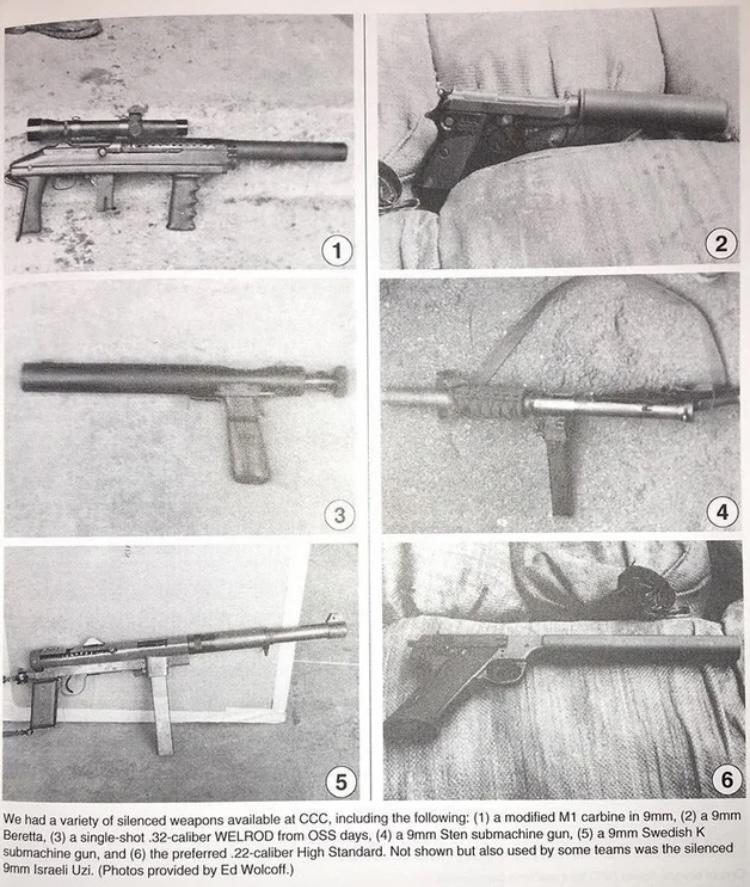
2.7. Other weapons
2.7.1. Highly Modified M1 Carbine
The M1 carbine was first adopted by the United States during World War II. It saw service well in the Vietnam War, primarily by rear echelon and special operations troops. Much like today's special operations forces, MACV-SOG soldiers modified their equipment to suit their needs. The image shows an M1 carbine with the stock cut, converted from .30 Carbine to 9x19mm. It was also modified with the addition of enlarged optics, a foregrip and a suppressor.
2.7.2. Beretta 951 removed
Today, 9x19mm handguns are used by almost every military and police force in the Western Hemisphere, but in the late 1960s and early 1970s they were quite rare. It was the beginning of the era Wonder Nine , a colloquialism for the sudden rise of increased capacity 9mm handguns flooding the market. Prior to this, soldiers and police were limited to 6 round revolvers and 7-8 round self-loading pistols. However, the Beretta 951 was the precursor to the well-known Beretta 92 or M9. The one pictured is equipped with a suppressor, probably used as a sentry cap , a silent weapon used to eliminate an individual enemy without alerting surrounding forces. MACV-SOG operators also used the Browning Hi-Power, another new marvel designed by the same man who designed the M1911.
2.7.3. Welrod
The Welrod was designed from the outset to be a sentry by Britain's SOE during World War II. It has no automatic reciprocating parts, bored ports in the barrel, and a large suppressor. The lack of alternate parts means that when fired there is nothing moving that can produce sound. Holes drilled into the barrel reduce the pressure behind the 9mm bullet, meaning it never reaches supersonic speeds and therefore there is no supersonic boom when fired. Finally, the suppressor slows down the gases produced by the shot of the bullet. The culmination of these three factors is that when the Welrod is fired, the loudest noise comes from the bullet hitting its target.

2.7.4. Sten Gun and Swedish K
World War II saw an increase in the use of submachine guns by almost every country on the planet. They are light and compact but not very good outside of close combat. However, the dense foliage of the Vietnamese jungles saw occasional use of submachine guns due to the relatively short sight lines. It should be noted that none of these weapons are American-made. It is not because the United States lacked submachine guns in war stock. Rather, it was an additional denial factor for MACV-SOG.
2.7.5. Removed High Standard
The High Standard is another example of a sentinel. The pistol was chambered in .22 long-rifle (.22 LR), a caliber with an improper name. The .22 LR is one of the smallest common commercial calibers on the market and is very common in marksmanship competitions. The High Standard pistol shown is a competition target pistol modified to have a suppressor. Due to the small size of the .22 it is very easy to drop and subsonic loads are coincidentally common.
The .22 LR bullet is fast enough to break the sound barrier, but it will usually return below the sound barrier before it hits its target. Slipping between super and subsonic has a detrimental effect on accuracy. As a result, most .22 LR competition loads use a heavier bullet so it never breaks the sound barrier in the first place. This provided competitive shooters with a more accurate, MACV-SOG .22 LR cartridge with an easily obtainable subsonic cartridge to use as a sentry cap.
2.7.6. The Gyrojet
The MACV-SOG also tried its hand at experimental armament. The "Gyrojet" gun was a firearm that fired miniature rockets, called "Microjets", instead of bullets that gyroscopically kept the bullet balanced. It was surprisingly light and transportable and in turn was known to be used by the unit. [ source ] Although, as one might imagine, they were incredibly inaccurate and unreliable, which is why the concept has never been revisited in the last 80 years.
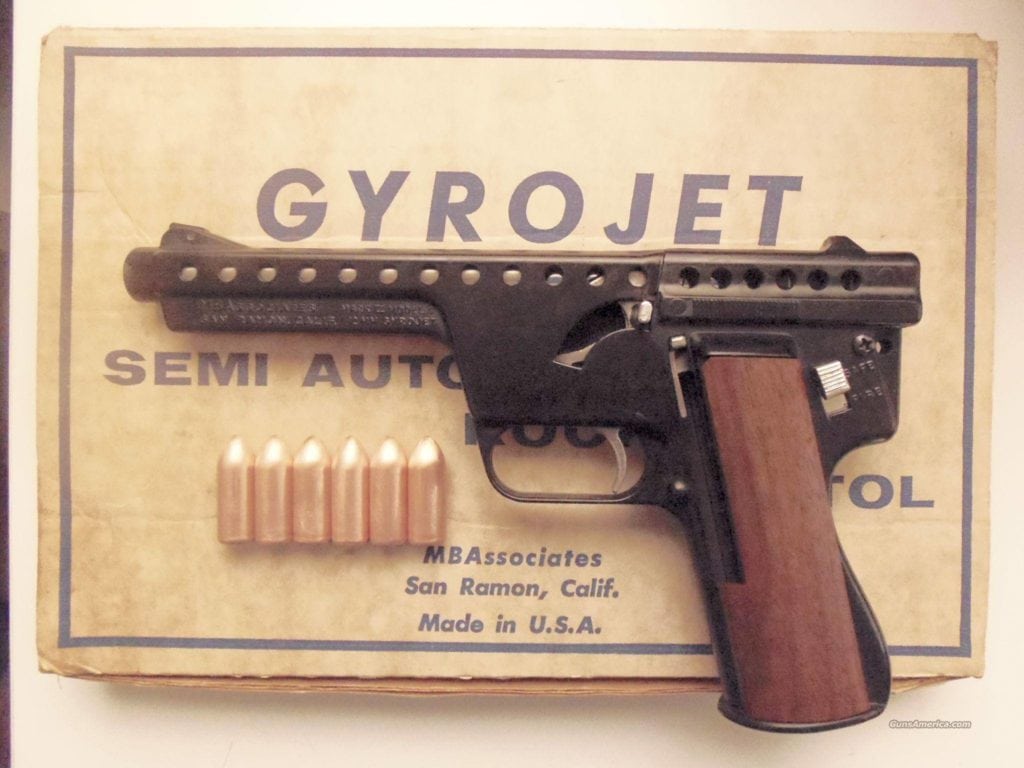
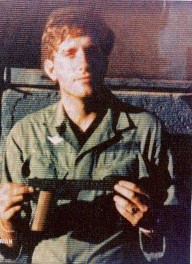
2.8. Case
MACV-SOG soldiers often used highly modified kit to suit their needs while on their irregular mission. During the Vietnam War soldiers were very limited in what kit they could use, there was much less of an aftermarket for equipment than there is now. As a result, soldiers often had to get creative. SOG operators usually carried as much ammunition as possible, sometimes as many as 34 20-round magazines. [ source ] In comparison, a standard combat load carried by infantrymen today is 7 magazines of 30 rounds.
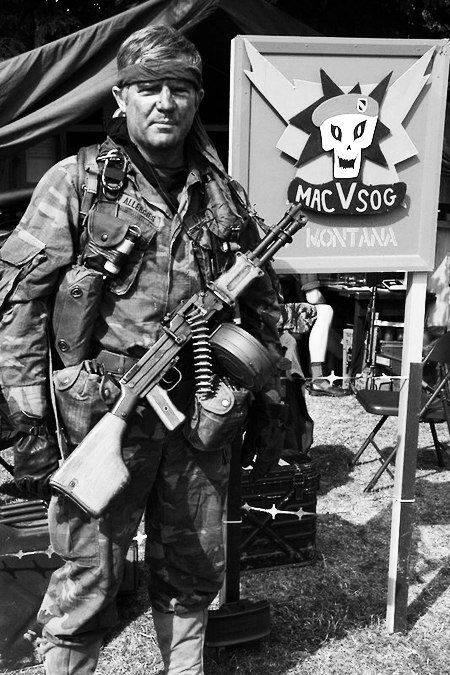
A widely used technique for carrying the massive loadout was to use canteen pouches to hold additional magazines. The canteen pouches were capable of holding five 20-round magazines with one ready in the pouch opening. Additionally, the MACV-SOG would use WWII kits, such as magazine belts for Browning Automatic Rifle (BAR) shooters.
Towards the end of the war, 30-round magazines for the M16/XM-177 became more common. Enemy forces often used Chinese Type 56 chest rigs to hold their 30-round AK magazines.
2.8.1. Additional equipment
In addition to the full load of ammunition and combat grenades that SOG operators would carry, they also carried a multitude of other mission essential items. Such as [ source ]:
- Pens
- Notebooks
- pen flares
- A plastic spoon
- Signaling mirror
- Maps
- Morphine clamps
- URC-10 Emergency Radio
- Radio PRC-25
- luminescent watch
- Compass
- Gloves
- Canteens (number dependent on water in operational area)
- Fixed blade knife
- Swiss knife
- Machete
- Smoke Grenades
- Bandages
- Strobe lights
- Recall D-ring
- Pomegranate with white phosphorus
- Water purification tablets
- M-17 gas mask
- Dehydrated rations
- insect repellent
- 3.6 m (12 ft) rope line
- Raincoat
- Toilet paper
2.8.2. McGuire Rig and STABO Harness
Fighting in the thick-canopy jungles meant that SOG operators had to get creative with their methods of exfiltration. Often the operators needed a quick extraction, but there was no opening in the trees big enough or flat enough to land a helicopter. As a result, they started using McGuire rigs. Named after Sergeant Major Charles McGuire, the McGuire rig was basically a long length of rope with a loop at the bottom big enough for a man to sit on. [ source ]

The McGuire platform worked well enough, but it had some serious flaws. It was extremely uncomfortable to sit on during long flights. Additionally, operators would sometimes fall off the platform if they were injured or if the helicopter encountered extreme weather conditions. As a result, SOG created the STABO harness, short for STabolized BOdy extraction harness . The STABO platform closely resembled a parachute harness, but its primary purpose was to secure the user directly to the helicopter's extraction line. Operators started hooking their kit directly to the STABO harness rather than wearing it on the standard ALICE load bearing gear which was a standard issue. [ source ]
2.9. Uniforms
MACV-SOG operators are best known for their camouflage fatigues Tiger Stripe. However, according to one of the best-known MACV-SOG vets, John Styker Myer, they were rarely used. Camouflage tiger stripe uniforms were more of a status symbol when off duty, distinguishing elite operators when on a base of operations. However, during missions, MACV-SOG operators used the standard green fatigues because they dried faster in the hot, humid jungle.
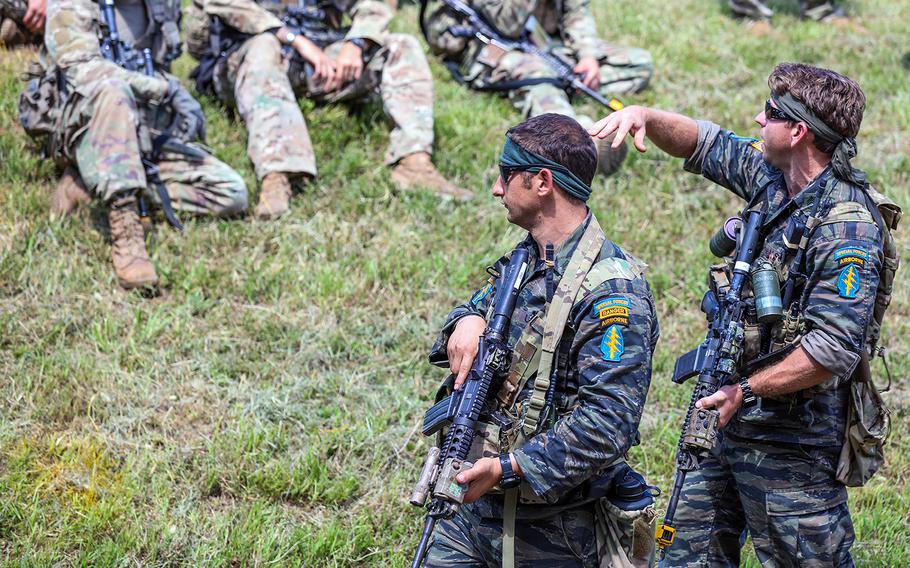
Although not particularly effective, the camouflage pattern has persisted in various forms. Central Intelligence Agency global response personnel and paramilitary operations officers have used a desert variant during their operations in Iraq and Afghanistan. Additionally, members of the 5th Special Forces Group used the ancient jungle tiger stripe during a training exercise as a tribute to their Vietnam-era Green Beret/MACV-SOG heritage.
3. Tactics. Techniques and procedures
As previously stated, the MACV SOG had a multitude of mission sets that they conducted in theatre, ranging from reconnaissance to psychological operations. SOG operators often worked with indigenous partner forces to carry out these missions. Together, these teams of American, Vietnamese, Cambodian, Hmong, and Montagnard soldiers essentially rewrote the doctrine of reconnaissance missions.
3.1. Insulation
Prior to long-range patrols, MACV SOG operators would enter a period of isolation. Patrolling deep behind enemy lines for several days, the slightest thing could compromise the operators. The smell of their sweat lingering in the air and their bodily waste could be the difference between life and death. The SOG operators were so efficient and had become such a problem for the Vietnamese that they set up anti-MACV SOG tracking teams to hunt them in the jungle. A professional Vietnamese tracker could tell the difference between the smell of bodily waste from someone on an American diet and a local diet. As a result, teams performing long range reconnaissance patrols (LRRP) often isolated themselves. They ate only local food, drank local drinks and smoked Vietnamese cigarettes. All for the purpose of masking their alien smell while patrolling the jungle. [ source ]
3.2. Partner Forces
MACV SOG's main stomping ground during the war was the Ho Chi Minh Trail. Although the name may conjure up images of a single short path through the jungle, in reality it was much more complex. The trail included over 3,000 km (1,864 mi) of roads, footpaths and tunnels. It stretched across the eastern border of Vietnam into Laos and Cambodia. During the war, the United States was not allowed to officially recognize cross-border operations, it could only operate in Vietnam. However, much of the trail is out of country. As a result, the Vietcong and North Vietnamese military used the track as a logistics pipeline to supply their forces. This is where MACV SOG and its partner forces come in.
The MACV SOG rose up primarily to act as a covert force that could carry out deniable missions in Laos and Cambodia. SOG agents themselves were recruited primarily from the Army Special Forces, primarily due to the unit's mission to train and fight alongside native partner forces. The MACV SOG recruited partner forces that were ideologically aligned with the US mission in Vietnam. The local warriors spoke the local dialects, knew the terrain, and assisted in denial if their mission was compromised. Together, these teams have become extremely close.
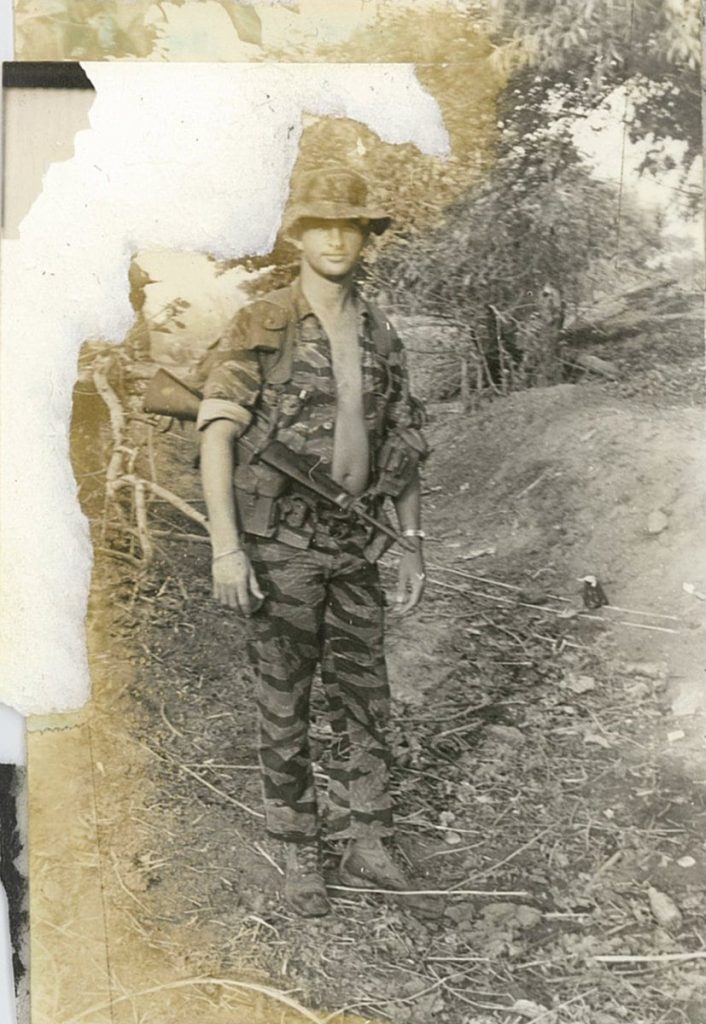
3.2.1. Garden Wristbands
Mountain forces often granted their American brethren Yard bracelets. These bracelets were made of brass cases hammered, polished and engraved with designs. Receiving a bracelet was considered a great honor and signified a lifelong friendship and commitment between the giver and recipient. [source] In turn, Americans who had developed close ties with their mountain counterparts often sponsored them to come to the United States after the American failure in Vietnam. As a result, there are mountain enclaves in unusual places across the United States.
3.3. Hatchets and spikes
The two main missions of MACV-SOG were direct action and reconnaissance. Hatchet teams were the main raiding force of the MACV SOG. They would conduct direct action missions and ambushes along the Ho Chi Minh Trail. Additionally, they could act as a rapid reaction force for compromised reconnaissance teams. A typical hatchet team consisted of 5 Americans and 30 native soldiers. For larger operations, multiple hatchet teams would be combined to form a havoc team to target enemy strongholds and conduct larger operations.
Recon teams were known as spike teams. They were usually named after US states, the typical name being something like ST Missouri. However, the use of the term rush teams fell out of favor and they began to be called reconnaissance teams or RTs. They kept the tradition of naming RTs after states with the occasional odd name like RT Bushmaster. Together, these forces constituted SLAM societies. SLAM meant Search, Locate, Destroy and Monitor . ( Source )
4. Notable Transactions
Although most details of MACV-SOG operations remain classified, MACV-SOG has undertaken numerous reconnaissance missions across borders. Many of these missions were the most dangerous and sensitive of any covert action undertaken at the time.
For example, OP-35, the "Ground Studies" group of MACV-SOG, undertook hundreds of cross-border operations between 1966 and 1972 [ source ]. It is believed that OP-35 had a strength of up to 2,500 American personnel and 8,000 native soldiers [ source ], segmented into smaller teams as small as 10 men. These tended to include a mix of American Green Berets, who specialized in unconventional warfare, as well as local combatants. These indigenous troops, colloquially known as "little people", came from several regional countries such as China, Cambodia and South Vietnam [ source ]. Indigenous peoples have been key to SOG's success. This is because they brought a wealth of information about the local geography, language and culture.

4.1. Operation 34A
Operation 34A began in 1961. This highly classified CIA operation was a series of largely unsuccessful covert attacks in North Vietnam. These failed missions, consisting of both air and naval infiltration, resulted in the deaths of personnel entering by parachute and boat.
To increase the chances of success, Operation 34A was transferred to MACV-SOG in July 1964. MACV-SOG was tasked with covert missions against North Vietnam. The unit was bolstered by an increase of 130 SIGINT personnel to support their surveillance and infiltration operations [ source ]. This led to a significant increase in the number of operations undertaken by MACV-SOG: evidence suggests that offensive operations were launched almost daily.
On the night of July 30, 1964, MACV-SOG launched a midnight naval assault on the Vietnamese islands of Hon Me and Hon Nieu. In the early hours of July 31, MACV-SOG personnel began their assault on the Vietnamese islands.
However, the attacks on both islands failed. On Hon Me, South Vietnamese agents opened fire from the shore, forcing the United States to retreat. This rendered their plan to lay explosive charges totally unsuccessful. On Hon Neiu, the result was similar: American forces withdrew within 45 minutes of the start of their offensive [ source ].
4.2. The Gulf of Tonkin Incident
Following Operation 34A, North Vietnamese forces grew increasingly suspicious of the American naval presence, building up their own presence around the islands of Hon Me and Hon Nieu. Their increased SIGINT capabilities meant increased surveillance of American ships. While US naval forces did intercept Vietnamese messages indicating they were launching imminent offensives on US shipping, these were largely ignored [ source ]. As a result, on August 2, the USS Maddox was attacked by 3 Vietnamese torpedo boats.
The Gulf of Tonkin Incident directly led to increased US involvement in the Vietnam War. The U.S. Congress passed the Gulf of Tonkin Resolution on August 7, 1964. This resolution gave President Johnson authority to "retaliate and promote the maintenance of international peace and security in Southeast Asia" [ source]. This effectively gave the US government a legal basis to become more involved in the Vietnam War.
While the United States initially blamed North Vietnam for the unplanned bombings, later declassified documents showed MACV-SOG involvement in covert surveillance and attack operations prior to the incident, underscoring culpability. the United States.
4.3. A Vietnamese Thanksgiving
On Thanksgiving Day of 1968, MACV-SOG was tasked with arguably its toughest mission yet. Army Intelligence had lost the position of several divisions of the North Vietnamese Army. This meant that there were 30,000 North Vietnamese soldiers missing.
The MACV-SOG was tasked with locating enemy troops to update U.S. Army intelligence. This was attributed to a specific MACV-SOG team that was best placed in the area where the troops were last: ST Idaho. ST Idaho consisted of only six men: four native troops and two green berets [ source ]. They were led by John Stryker Meyer as pictured below.
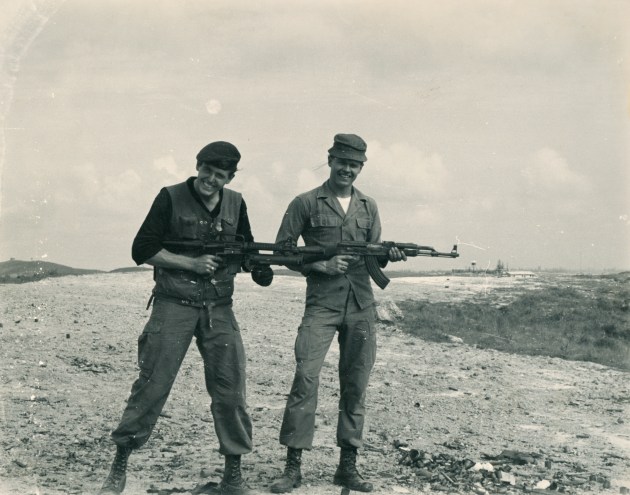
4.3.1. 6 against 30,000
The State Department had strict rules for engagement in Cambodia, which meant that air support was not an option while they were on this mission. Meyer and ST Idaho were completely alone.
Meyer and his team began their search for the missing troops. Soon they located an enemy camp that seemed empty. The team raided the camp looking for clues to the whereabouts of the enemy. However, after a short time, one of the team's native personnel was alerted to an enemy approach. ST Idaho quickly began the exfiltration, and just in time hundreds of North Vietnamese soldiers began flooding the camp, opening fire on the MACV-SOG unit [ source ].
ST Idaho moved quickly towards their landing zone, throwing grenades and firing at the North Vietnamese forces as they moved. American gunships piloted by Green Hornets airlifted ST Idaho away from the landing zone, with the team barely escaping with their lives.
4.4. Other operations
Other common missions included counterintelligence by tapping enemy communications systems, infiltrating enemy strongholds, and any other mission that would allow US forces to gain more information on the numbers and location Vietnamese troops all over the continent [ source ]. As the group consisted of highly trained troops drawn from well-trained American forces, the group regularly undertook specialized operations such as high-altitude parachute jumps behind enemy lines and naval missions [ source ]. MACV-SOG was also responsible for the recovery of wounded soldiers.
5. Dissolution and Recognition
MACV-SOG, which contributed to the war effort, has one of the highest casualty rates of any US force. The force's casualty rate exceeded 100% - every member of the SOG was wounded at least once, and more than half the force was killed in action [ source ].
The MACV-SOG has finally been deactivated the 29th March 1973 [ source ]. Subsequently, this became US National Vietnam War Veterans Day in 2017. Due to the covert nature of the work, much of the information surrounding the covert force only becomes available in the public domain.
In 2001, MACV-SOG received the Presidential Unit Citation for its efforts during the 1960s and 1970s [ source ].
6. Summary
The discreetly named “Military Assistance Command” was a major clandestine intelligence service operating throughout Asia. Ultimately, the group's operations contributed to the success of the American war effort in Vietnam.
0 comments